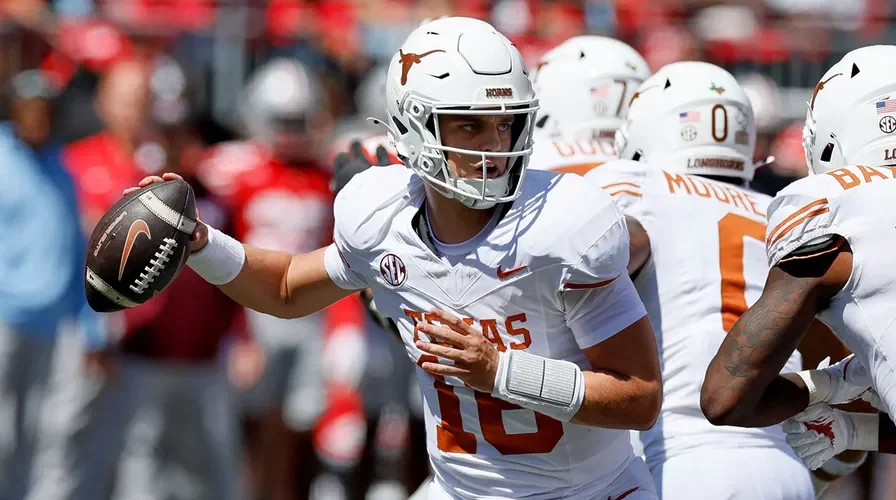Arch Manning, QB vs #3 Ohio State 2025
Player: Arch Manning, QB, Texas
Height: 6'4"
Weight: 218 lbs
Class: RS Sophomore - 2026 Draft Eligible
Opponent: #3 Ohio State
Year: 2025
Final Stat Line:
17/30, 170 Pass Yards, 1 Pass TD, 1 INT
10 Rushes, 38 Rush Yards
Game Overview
This was not a good game for Arch Manning. From start to finish, he looked inconsistent, rushed, and mechanically unsound. Too often it felt like the game was moving faster than he was ready for — leading to hurried throws, sloppy footwork, and questionable decisions. The first half was especially rough, with missed layups and turnover-worthy plays that killed momentum.
That said, context matters. This was Manning’s first real start, and it came against the reigning national champions — a situation that would challenge almost any young quarterback. While the negatives outweighed the positives, there were still a few moments in the second half that hinted at the quarterback he could become with more poise, experience, and refinement.
Film Breakdown – The Ugly, The Bad, & The Good
The Ugly
The “Ugly” moments were the kind you can’t have at any level — mental mistakes that lead directly to turnover opportunities for the defense. The most damaging came at 3:09 in the 3rd. Manning had a clean pocket, stepped up into open space, and still forced a throw toward the right sideline. The defender read it the whole way, easily undercutting the route for an interception. This wasn’t a case of pressure forcing his hand — it was a flat-out bad read and a failure to process the coverage.
3:90 in the 3rd. 2nd & 12 – INT
Later in the 4th, at 10:43, a play-action rollout to the right started off looking fine, but with a rusher closing quickly, Manning panicked. Instead of resetting or throwing the ball away, he tried to get it out on the move, off-balance, and without proper mechanics. The throw went right to a defender’s hands, who simply dropped the interception. Both of these plays weren’t just mechanical errors — they were situational failures, showing a lack of patience, an overreliance on arm talent, and a need to improve pocket awareness. Against a defense of this caliber, those mistakes are almost always punished.
10:43 in the 4th. 1st & 10 - Almost Picked
The Bad
The “Bad” plays were less catastrophic but still not great to see, showing how inconsistency on basic execution can stall an offense. The first play of the game, Manning rolled to his right on a play-action concept and had a receiver wide open with a clean throwing lane. This is the kind of throw that needs to be automatic — and yet, the ball died short, forcing the receiver to work back and preventing any chance at yards after the catch. It was likely early-game adrenaline and rushed mechanics, but at this level, those can’t get in the way of a free completion.
15:00 in the 1st. 1st & 10 - Incompletion
The second example, at 7:56 in the 2nd, was from a perfectly clean pocket. Manning read the middle of the field well, stepped into the throw, and… fired it low, bouncing it before it reached the receiver. These aren’t tight-window, high-degree-of-difficulty plays — they’re layups. Missing them not only kills drives, but also puts more pressure on the quarterback to make up for it later with harder throws. In this game, that pressure compounded.
7:56 in the 2nd. 1st & 10 - Incompletion
The Good
While the low points stood out, the “Good” moments serve as a reminder that Manning’s physical tools are still very real — they just need to be paired with consistency and control. At 12:17 in the 3rd, facing 2nd and 13, interior pressure flushed him left. Instead of freezing, he kept his eyes up, accelerated past the edge defender, and turned the corner for a 14-yard gain and a first down. It was the type of instinctive, athletic play that can break a defense’s back when executed at the right time.
12:17 in the 3rd. 2nd & 13 - 14 Yard Scramble
At 2:21 in the 4th, we saw his arm talent on full display. With the pocket holding up just long enough, Manning dropped a 30-yard sideline throw between two defenders, hitting his receiver in stride. This was NFL-level ball placement — the kind of throw that wins you games if you can make it consistently.
2:21 in the 4th. 2nd & 10 - 30 Yard Pass
Then, at 3:35 in the 4th, he had his best pass of the day. The defense brought pressure, but the blitz was picked up. Manning stepped up into the pocket, saw his man one-on-one downfield, and delivered a perfectly placed 32-yard touchdown — high enough and outside enough that only his receiver could go get it. It was the kind of throw that makes you understand the hype.
3:35 in the 4th. 3rd & 10 - TD Pass
Final Thoughts
For most of this game, Arch Manning looked like a quarterback still adjusting to the speed, complexity, and physical demands of high-level play. The mechanical issues, rushed processing, and shaky pocket composure outweighed the highlights. Still, it’s worth remembering that this was his first real start — and it came against the reigning national champions. Many young QBs would struggle in that spot.
If he can slow the game down in his head, clean up his footwork, and trust his reads, those late-game flashes could become a much larger part of his performance. Until then, the gap between his ceiling and his current play remains wide — and the challenge for Manning will be to bridge it before the mistakes start defining him more than the talent does.
